Industry Outlook: In the trenches
New trenchers meet changing customer needs
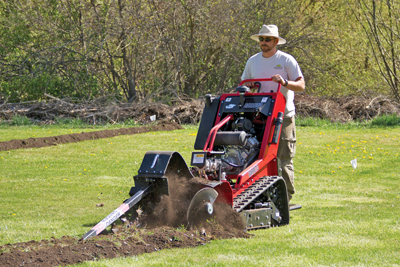 |
| Tracks have helped trenchers become a more viable option for users and that is why Barreto added a track trencher to its product line. |
Trenchers are becoming increasingly popular as rental customers work in tighter areas and need to disturb the work area less. They are also looking for faster, more efficient equipment to do the job; new-generation trenchers are addressing those needs.
Pro Contractor Rentals queried leading trencher manufacturers for their insights about evolving rental customer demands and how they are fulfilling those needs. Here’s what we found out:
 |
|
Tim Phelps, Barreto Mfg. |
Right-sized fleets meet rental needs
There are many challenges that end users and rental centers face in renting and using trenchers. Having the correct size unit in their fleet for the customer’s application is particularly challenging for smaller rental centers with lower inventory. If the rental center does not have the right sized unit on the lot, the end user may be forced to rent a machine that does not best fit the project. Or worse, they seek a solution at a competing rental center. Not having the right tool for the job can be frustrating, time consuming and costly for the end user or contractor.
Maintenance required by most trenchers can also be a challenge. Unreliable equipment or models that require excessive maintenance adds to unavailability and affects ROI due to loss of income, labor costs and repair part costs.
The biggest change in trenchers has taken place with their drive systems, especially with track machines. Tracks have helped trenchers become a more viable option for users and that is why Barreto added a track trencher to its product line. Operator controls are also improving. Barreto’s controls are designed to be easier to use and more intuitive and high-wear cables have been replaced with a rod linkage, which reduces maintenance and down time.
Barreto’s newest STK series track trencher features an Independent Floating Track System that uses independent undercarriage idlers that move in response to the terrain. This keeps a significant portion of the track in contact with the terrain at all times, reducing ground pressure and increasing traction. The movement of the middle and rear idlers act as suspension and smooth the overall movement of the trencher. This provides for a more fluid operation than traditional track trenchers when working in rough and uneven conditions.
End users like the simplicity of Barreto controls, and the individual track controls make steering simple. For example, the Barreto RTK stand-on track trencher features a fixed platform for operator comfort. Rental customers also like the Barreto detachable front end, which allows them to quickly change between attachments. Our accessible, yet protected components reduce downtime and maintenance costs.
The Barreto Adjustable Trenching Control system, which uses rod linkage instead of costly, high-maintenance cables, can modify the trenching speed of the tracks individually while on the go, giving the operator the ability to keep the trench straight even while working on uneven terrain.
 |
| Brandon Wright, Digga USA technical support manager |
Trenchers as attachments gaining popularity
Rental customers just want to get the job done with precision, power and efficiency.
One of the biggest challenges for end users and rental centers when using or renting trenchers is the need to match the trencher or trencher attachment to the application. Ground conditions vary greatly, even within a similar geography. Balancing the different chain sizes and tooth configurations to the job site conditions that the rental center hasn’t personally seen can be a problem. There are four basic chain configurations with multiple variations available – cupped, shark, rock or combo cupped/shark teeth combinations – and each type has advantages in certain ground conditions.
Another challenge when renting trencher attachments is carefully matching the right trencher attachment with the right prime mover. The rental center should always match the attachment to the hydraulic capabilities of the host machine to make certain the attachment receives sufficient flow and pressure to get the work done properly and safely.
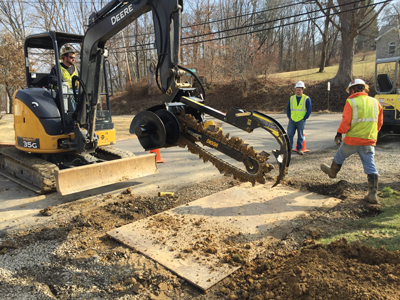 |
|
Boom-mounted trenchers allow utility contractors to trench in tight spots near houses and work around fences and obstructions. |
Properly matching the trencher with the expectations of the end user is also critical to a good rental experience. Trenchers and trencher attachments work very well within their design parameters. As long as the operator is trained on the proper operation of the trencher and the unit is matched to the description of the ground conditions and application, the rental experience will be a good one. As an example, trencher booms can be damaged from side loading if the operator tries to curve the trench. Proper pre-rental training can avoid that problem.
As host machines continue to increase their load-carrying and hydraulic-system capabilities, the role of trencher attachments in the segment will continue to expand. At one time, the rental segment relied almost exclusively on single-purpose trenching machines and skid steer loader-mounted machines. Many of today’s mini- and midi-excavator-mounted machines are capable of carrying trenching attachments with greater versatility in certain applications. Also, the growth of trencher attachments for the mini-skid steer machines has been phenomenal.
One of the biggest challenges in the operation of any trencher or attachment has always been the difficulty of keeping a consistent trench depth during operation. Many factors affect the finish depth of the trench, including the angle of the boom, the depth of the boom relative to the ground, and the amount of dirt fallback into the trench.
One of the new preferred features now available is a large high-visibility skid foot with preset digging depths. With these tools, the operator only needs to watch and keep the skid foot on the ground to keep the trench depth consistent.
New larger spoil augers carry more dirt away from the trench instead of allowing to fall back in the trench. This also keeps the dirt away when setting the pipe or cable in the trench.
New heavy-duty spring-loaded crumber designs enable the operator to stay in the cab during the cut instead of climbing out to swing the crumber down. Proper crumber operation also provides a more consistent trench depth.
All of these new features available on the market today allow for faster production and more job-site efficiency, which leads to a more rapid return on the rental investment.
The new highly efficient planetary drives on today’s trenchers maximize torque transmission to the trencher chain for a cleaner finish, faster job completion and less maintenance than the older direct- or chain-drive systems.
The biggest trend that we see today is the move toward using trencher attachments mounted on excavators. The boom-mounted trenchers allow utility contractors to trench in tight spots near houses and work around fences and obstructions. With the attachment quick-change capabilities available today, the contractor can rapidly convert the same rental unit to conventional digging for junctions and connections.
With four basic chain-tooth platforms and many different spacing configurations available on today’s machines, the rental center can easily equip the trencher with chains that match the requirements of the specific application, assuring the end user will achieve maximum performance on his specific job.
 |
| Chris Thompson, Ditch Witch product manager, compact equipment |
Compact equipment gaining attention
Trencher operators are increasingly concerned with proper turf management and restoration when on a job. The need to restore the job site to its previous condition has presented some challenges for users. As the demand for fiber-optic installations continues to grow, especially on private properties, it is critical to assure proper job site restoration from the street to the home.
The size of trenching equipment impacts a variety of compact job sites. Some operators find it a challenge to secure the right size trencher to match tight and compact job sites. As newer technology requires installation in smaller spaces, especially in urban areas, compact machines will be in higher demand.
Operators continue to seek equipment that increases productivity, regardless of job site size. As landscape and utility contractors seek to get the most bang for their buck, rental centers need to keep their machines operating at maximum capacity so they can spend more time on the job and less time in the shop for regular maintenance. Newer innovations, including the minimization of daily maintenance points and grease points, help rental centers solve this problem. For example, the Ditch Witch C- and CX-Series walk-behind trenchers have no daily grease points and are designed to offer easy access to all machine’s components. These updated designs simplify maintenance and help keep the machines rental-ready, increasing overall profitability for rental centers and improving productivity for operators.
In the past, rental centers and operators tended to select lower-horsepower trenchers, typically in the 7- to 9-hp. range. While intending to save on upfront costs, rental companies soon realized these trenchers were not powerful or durable enough to match most job-site requirements. That has resulted in some rental centers moving away from offering lower-horsepower equipment. They are finding this cost effective because more powerful trenchers can help reduce total cost of ownership; these models are more durable as well. That translates to getting landscape and utility projects done on time and on budget.
Improved trencher designs continue to ease serviceability. The elimination of the daily grease points helps increase rental center profitability. With the maintenance simplifications and costs savings associated with the larger horsepower equipment, rental centers are moving away from focusing on upfront costs, and are taking advantage of equipment-design innovations to lower their total cost of ownership.
Today’s rental centers can increase profitability by selecting equipment with dedicated support offered through a robust manufacturer’s dealer network, such as the global Ditch Witch network of dealers. Without this type of support, overall equipment service and performance tends to suffer, impacting the bottom line for end users and rental centers.
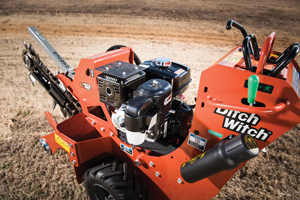 |
| Ditch Witch C- and CX-Series walk-behind trenchers have no daily grease points and are designed to offer easy access to all machine components. |
Today’s trenchers are designed specifically for operator comfort. For example, the new Ditch Witch C- and CX-series walk-behind trenchers offer an ergonomic design with advanced hand grips that alleviate operator hand pressure for long hours of operation. Developments in track design have also yielded increased maneuverability on job sites. The Ditch Witch tracked models eliminate the trail wheel and now feature an exclusive design with a shorter left track and longer right track, delivering excellent traction. This makes it easy for operators to efficiently move around compact job sites.
A key focus of development for the industry includes increasing trencher horsepower to provide operators and rental centers with the power to conquer a variety of jobs. In addition to the increased power, design innovations focused on digging capacity. Some newer machines, such as the Ditch Witch C30X walk-behind trencher, provide increased digging depths up to 48 inches instead of the previous maximum depth of 36 inches. In the past, walk-behind models featured shallower maximum digging depths and operators could not always dig deep enough to install the product. In these instances, operators would be forced to use a ride-on trencher model to get the job done, increasing project time and costs. Increased depth saves the operators money and reduces job-site congestion. Today’s new smaller, walk-behind trencher models help operators reduce job-site footprint while digging deeper than previous walk-behind units.
 |
|
Mike Hale, Little Beaver, Inc. |
Mini-trenchers, big results
Rental centers, thanks in part to do-it-yourself homeowners, have long been a primary market for mini trenchers. For this reason, most are designed for ease of use and inexpensive maintenance, helping them appeal to inexperienced customers and rental center owners.
Over the past couple of decades, there have been few changes to mini-trencher designs. However, with evolving customer preferences and significant variations between manufacturers, some rental centers may benefit from re-evaluating their trencher fleets.
Many new homeowners, particularly younger individuals, associate trenching with large chain models. In reality, the overlap in applications between chain trenchers and mini trenchers is slim. Typically, the width and depth of a trench determines which style of trencher should be used. For a 4- or 6-inch trench that’s 3 to 4 feet deep, a large chain trencher is required. But, for a majority of homeowner DIY projects, such as sprinkler systems, landscape edging and low-voltage wiring, mini trenchers work better. These projects require narrow trenches that range in depth from 6 to 12 inches. First-time trenching customers are often pleasantly surprised by the ease of use, speed and compact size of mini trenchers.
While the manageable size of mini-trenchers is a benefit they all share, the similarities often end there. Even the direction of operation varies. Nearly all models require the operator to walk backward while pulling the trencher. The safer alternative is a unit the operator can push while walking forward. This affords the user better maneuverability and improved control. When trenching perpendicular to a building, push-forward models make it possible to dig close to the structure, in most cases, within a foot. Other mini trenchers cannot dig within 4 feet of a building because the operator and the equipment’s handles get in the way.
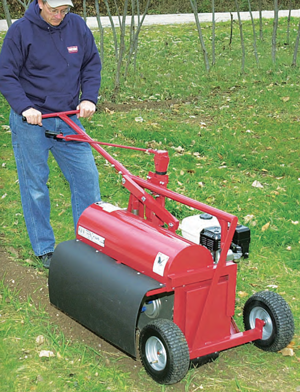 |
| For a majority of homeowner DIY projects, such as sprinkler systems, landscape edging and low-voltage wiring, mini trenchers work better. |
Depth gauges also help improve trenching efficiency. By continually monitoring the blade depth, the operator can avoid trenching deeper than necessary while also eliminating the need to double back if a portion of the trench is not deep enough.
Features that reduce turf damage and make cleanup easy also keep customers coming back. Pneumatic tires, for example, will reduce the possibility of turf damage. For fast cleanup, most individuals prefer trenchers that uniformly deposit soil along one side of the trench, making backfill easy when the job is complete. Models designed to reduce cupping, or excessive settling in the back-filled trench, allow the turf to heal faster.
For rental centers, it’s also important that the trencher can tolerate regular abuse and be inexpensive to maintain. Trenchers with replaceable teeth, for example, reduce maintenance costs by eliminating the need to replace the entire blade or chain when only a few teeth are damaged.
A centrifugal clutch is another feature that reduces the need for costly repairs. By automatically slipping when the blade hits a solid object, the clutch can prevent excessive damage to the machine and blade.
Rental centers are tasked with offering mini trenchers that appeal to DIY trenching customers while also being durable enough to tolerate the abuse of an inexperienced operator. When rental owners find the right trencher, they realize these small and versatile machines deliver steady returns.
 |
| Sean Halloran, Toro marketing manager |
Durability and ease-of-use drive trencher profitability
The primary challenges that rental stores and their customers face on a daily basis can be characterized into two distinct categories — controls and maneuverability and productivity.
As far as controls and maneuverability are concerned, operators need to feel comfortable behind the controls of the trencher.
Over the course of the trencher’s lifetime, it will be handled by many different operators with varying skill levels, so the first rule for manufacturers of walk-behind trenchers is to make sure the controls are simple and intuitive. It’s also equally important to have a maneuverable machine.
Overall trenching productivity is another important factor for rental stores and their customers to consider. Machine horsepower, transport speed and fuel capacity figure into productivity. Rental centers and their customers need to consider primary and auxiliary hydraulic flow, which is responsible for delivering the right amount of power to the trencher boom. Rental customers may also find a pivoting trencher head useful. This feature provides high ground clearance during transport.
Rental stores can help their customers find the right machine by fully understanding walk-behind trencher options on the market and then offering solutions that are focused on simplicity of controls, maneuverability of the machine and overall productivity of the trenching unit.
For the rental segment specifically, some manufacturers, including Toro, have focused on making what used to be a very complex piece of machinery very simple to operate. Rental stores serve a broad range of customers with extremely varied experience levels, so having simple controls and an intuitive machine reduces the learning curve for the largest number of potential customers.
Durability has been and will continue to be an important factor for equipment going into rental fleets. Rental centers can increase the profitability of their trencher inventory by choosing equipment that is built with quality, heavy-duty components and backed by trusted manufacturers.
Trencher manufacturers are adding features and technology that benefit the end user, but units must also continue to be easy to use and durable. A trencher, with all the bells and whistles but is not rugged and simple to use, is not the right choice for rental stores and their customers.
There are a number of accessory and attachment options that can help broaden trencher capabilities on-site. Options include a trencher crumber, which smoothes the bottom of the trench, or a bore drive head to easily bore under driveways or sidewalks to simplify irrigation or cable installations. Other options for the Toro line of TRX trenchers include custom trailers for easy transport and backfill blade attachments that reduce labor and increase job site productivity.
Chain options are needed to best match the unit to the job. It is largely dependent on the terrain to be trenched. The most basic and economic configurations are soil or cup chains. The teeth act as shovels and simply remove dirt from the trench. Rock chains, commonly called shark chains, are designed to cut through more challenging soil conditions. For extreme conditions, including frozen ground or extremely rocky terrain, the carbide-tipped teeth of bullet chain, also known as an alligator chain, is the best option.
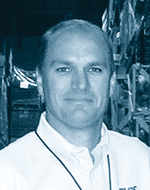 |
| James Day, Turf Teq general manager |
Productivity driving trencher rentals
Operator safety is always the first concern for renting and operating any type of power equipment. The rental equipment dealer must provide the end user with proper training, and the end user must follow the operating instructions to get their work completed in a safe and efficient manner. Turf Teq takes pride in designing and manufacturing highly productive equipment that will get the job finished quickly and keep the operator safe.
Today, productivity is driving the trencher rental market. There are hundreds of niche products for almost every job conceivable and trenching is certainly no exception.
Rental equipment tends to be more basic with less options and fewer creature comforts, but rental customers expect new trencher models to be increasingly productive. Rental dealers must stay in tune with the latest products available for their customers to be as productive as possible and continue returning to rent their equipment.
In the mini-trenching market, we are seeing more people renting self-propelled equipment that is easy to use and cause less operator fatigue. The rental dealer must ask enough questions to understand what piece of equipment will fit the end user’s job. If a customer has a trenching project with long runs, rocky conditions or steep hills, they will not like a trencher that the operator has to pull backward. In these cases, Turf Teq equipment that is self-propelled and operates by walking forward would be a viable option.
Turf Teq offers a variety of blade profiles: six for trenching, two for landscape bed edging and one for sidewalk edging. These blade options are all available on the same machine. This variety allows the rental dealer to meet several different customer demands with a single machine. Turf Teq equipment also has the ability to change attachments, allowing a single self-propelled unit to be used as a power broom, power rake, power plow or a field and brush cutter.
 |
| Matt Hutchinson, Vermeer product manager, tree care, rental and landscape |
Cater to the needs of the operator
The adage “one size fits all” does not apply to pedestrian trenchers because no two jobs are the same. Soil conditions, trench depth and width are factors that every operator considers before a job and will determine what size machine they need, and rental stores need to be able to meet those expectations.
Sending out a trencher that has a boom or a chain that is too long or isn’t wide enough for a customer’s specific job compromises the overall operator’s experience and could affect repeat business. That’s why rental companies stock several trenchers with different boom sizes, chain widths and tooth configurations.
Ease of operation is the next on the list of operator needs. Most pedestrian trenchers are rented by contractors and DIYers who do not frequently operate these machines, so how quickly they learn to operate the controls is important. Operators are looking for reliable and straightforward functionality. The controls need to be intuitive to the operator and they need to be able to set and easily maintain a specific trenching depth.
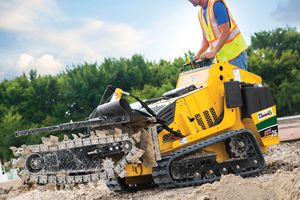 |
|
Tracks have made it possible to eliminate the tail wheel found on most wheeled units, resulting in enhanced maneuverability and depth control in uneven ground conditions. Tracks also eliminate flat-tire concerns. |
The rental market is also trending toward higher horsepower and tracked machines. These units are more versatile because they can perform in a wider range of applications and provide better flotation in soft or sensitive ground conditions. Tracks have made it possible to eliminate the tail wheel found on most wheeled units, resulting in enhanced maneuverability and depth control in uneven ground conditions. Tracks also eliminate flat-tire concerns.
Rental companies can also optimize the operator experience with pedestrian trenchers by offering additional attachments. Vermeer trenchers can be outfitted with an optional angling backfill blade to push the spoil back in the trench; a boring attachment to make installations under sidewalks and driveways where an open trench isn’t an option. These items create more value for the base machine by offering more options to the renter.
Delivering a positive operator experience will help rental companies grow their customer base and help retain current customers. Vermeer experts understand the needs of the operator and the rental company, which is why we’re committed to developing innovative products that are reliable, easy to operate, productive and deliver a high rate of return.









